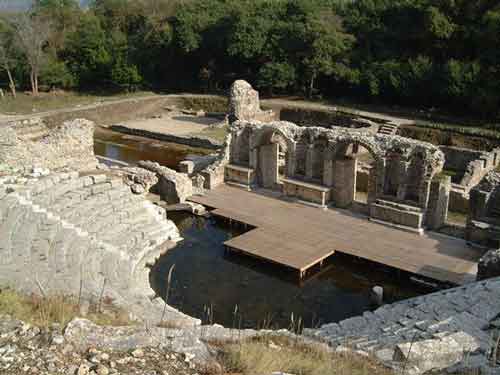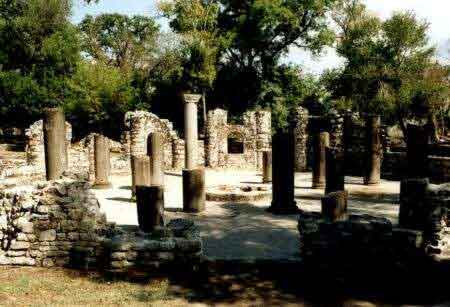.

(Information about this image)
Butrint (Albanian: Butrint or Butrinti) is a city and an archeological site in Albania, close to the Greek border. Its ancient name was Vouthroton, the modern name for the Roman city of Buthrotum. It is located in a bluff overlooking the Vivari Channel. Inhabited sinceprehistoric times, Butrint has been the site of a Greek colony, a Roman city and a bishopric.
Ancient ages
Butrint was originally an Illyrian town within the ancient region of Epirus. According to Roman writer Virgil, its legendary founder was the Trojan seer Helenus who had married Andromache and moved West after the fall of Troy. Historian Dionysos of Halicarnassos wrote that Aeneas visited Butrint after his own escape.
First archaeological evidence of sedentary occupation is dated to between 10th and 8th centuries BC. Original settlement probably sold food to Corfu and had a fort and sanctuary. Butrint was in a strategically important place due its access to the Straits of Corfu. By the 4th century BC it had grown in importance and included amphitheatre, sanctuary to Aesclepius and an agora.

Remains of an amphitheater and part of agora (Photo by Marc Morell)
Romans took Butrint over in 167 BC and in 228 it became a Roman protectorate alongside Corfu. In the next century it became a part of a province of Illyricum. In 44 BC Caesar designated Butrint as a reward colony for soldiers that had fought on his side again Pompey. Local landholder Titus Pomponius Atticus objected to Cicero who lobbied against the plan in the senate. As a result Butrint received only small numbers of colonists.
In 31 BC victorious emperor Augustus re-established the plan to make Butrint a veterans' colony. New residents expanded the city and the construction included an aqueduct, a Roman bathhouse and a nymphaeum.
In the late Roman era, Butrint became a major port in the province of Old Epirus and site of local power struggles. In the 3rd century AD an earthquake destroyed major part of the town. Excavations have revealed that at that time city was already in decline and becoming a manufacturing center. Rebuilt city included the grand Triconch Palace that was built around 425 AD.
In the early 6th century AD, Butrint became a bishopric and new construction included a large baptistery and basilica. Emperor Justinian strengthened the walls of the city. Goths sacked Butrint in 550 AD, which begun a new decline.
By the 7th century, Butrint fell under Slavic control. The city apparently diminished during the following centuries until sometime in the 9th century when the Byzantine Empire took control of the area during its struggle against the Despotate of Epirus. In the following centuries the area was a site of conflicts between the Byzantines and the Angevins and Venetians and the city changed hands many times. In 1267 Charles of Anjou took control of both Butrint and Corfu and renovated the walls and the basilica.
The Republic of Venice bought the area from the Angevins in 1386. Venetian merchants occupied only part of the area. In 1490 they began to build a tower and a small fort. The area was lightly settled afterwards.
In 1797 Butrint came under French control when Venice gave it to Napoleon as a part of a peace settlement. In 1799 Ottoman Empire conquered it and it became a part of the empire until the Albanian independence in 1917. By that time the site of the original city had been unoccupied for centuries and marches had taken it over. [1]

Remains of a chapel
Archaeological excavations
The first modern archaeological excavations begun in 1928 when the Fascist government of Mussolini's Italy sent an expedition to Butrint. Its leader was an Italian archaeologist, Luigi Ugolini. Ugolini died in 1936 but the excavations continued until 1943 and the Second World War. They uncovered the Hellenic part of the city and a gate they named the "Lion Gate".
After the communist government of Enver Hoxha took Albania over in 1944, foreign archaeologists were expelled. Albanian archaeologist Hasan Ceka continued the work. Nikita Kruschev visited the ruins in 1959 and suggested that Hoxha should turn the area into a submarine base. The national Institute of Archaeology began larger scale excavations in the 1970's.
After the collapse of the communist government in 1992, the new government planned to turn the site into an airport. The same year remains of Butrint were included in the UNESCO list of World Heritage Sites. Economical collapse of 1997 stopped the airport plane plan and UNESCO reclassified it as a "Site in Danger" because of looting, lack of protection, management and conservation.
The Albanian Government established the Butrint National Park in 2000. Under the leadership of its first Director, Auron Tare, the situation was improved to the point that UNESCO removed the site from the danger list by 2005. An Archaeological Museum of Butrint opened in September 2005 in a medieval Venetian castle from the 14th century.
After the founding of the Butrint Foundation, the site has become a tourist destination. The Packard Humanities Institute funds archaeological projects in Butrint. Projects include those from the Institute of World Archaeology at the University of East Anglia, lead by Richard Hodges, and the Albanian Institute of Archaeology, lead by Ilir Gjepali. The projects also train new Albanian archaeologists.
Directions
Butrint is accessible from Saranda, along a road built in 1959 for a visit by the Soviet leader Nikita Krushchev. It is increasingly becoming a popular tourist attracting day-trippers from the nearby Greek holiday island of Corfu.
Further reading
Neritan Ceka: Butrint. A guide to the city and its monuments. London 1999.
Neritan Ceka: Buthrotum its history and monuments. Tirana 2002. ISBN 99927-801-2-6
Oliver J. Gilkes: The theatre at Butrint. Luigi Maria Ugolini's excavations at Butrint, 1928-1932. London 2003. ISBN 0-904887-44-8
Richard Hodges: Byzantine Butrint. Excavations and surveys 1994 - 99. Oxbow, Books Oxford 2004. ISBN 1-84217-158-5
Luigi M. Ugolini: L'acropoli di Butrinto. Roma 1942.
Luigi M. Ugolini: Butrinto. Il mito d'Enea; gli scavi. Roma 1937.
Jarrett A. Lobell: Ages of Albania. The ruins at Butrint reflect an extraordinary history, from the rise of the Iron Age to the fall of the Iron Curtain. In: Archaeology 59, 2(2006) Abstract.
Richard Hodges et. al.: Late Roman Butrint. Albania: survey and excavations, 1994-98. In: Archeologia Medievale 27(2000), 241-257. als pdf-File
Greece :
A - B - C - D - E - F - G - H - I - J - K - L - M -
N - O - P - Q - R - S - T - U - V - W - X - Y - Z
| Ancient Greece
Science, Technology , Medicine , Warfare, , Biographies , Life , Cities/Places/Maps , Arts , Literature , Philosophy ,Olympics, Mythology , History , Images Medieval Greece / Byzantine Empire Science, Technology, Arts, , Warfare , Literature, Biographies, Icons, History Modern Greece Cities, Islands, Regions, Fauna/Flora ,Biographies , History , Warfare, Science/Technology, Literature, Music , Arts , Film/Actors , Sport , Fashion --- |
Retrieved from "http://en.wikipedia.org/"
All text is available under the terms of the GNU Free Documentation License


